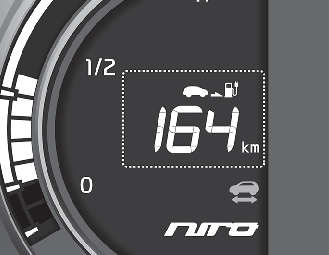Distance to Empty

You can check the distance the vehicle can be driven with the current battery amount.
-
Distance to empty may depend on many factors such as the charge amount of the high voltage battery, weather, temperature, durability of the battery, geographical features, and driving style.
-
Natural degradation may occur with the high voltage battery depending on the number of years the vehicle is used. This may reduce the distance to empty.
-
On average, a vehicle can drive approximately 385 km (Cruisetype)/246 km (City-type) or 239 miles (Cruise-type)/153 miles (City-type). However, the distance to empty can be changed from 280-500 km (174-310 miles) for Cruise-type and 170-320 km (106- 199 miles) for City-type depending on operation of the air conditioner/ heater and other various vehicle conditions.
When using the heater during cold weather or driving at high speed, the high voltage battery consumes a lot more electricity. This may reduce the distance to empty significantly.
-
The vehicle can stop shortly after the "---" has been displayed. When it is displayed, drive to a safe place to stop the vehicle. (The available range varies depending on driving speed, heater/air conditioner, weather, driving style, and other factors.)
-
Distance to empty that is displayed on the instrument cluster after completing a recharge may vary significantly depending on previous operating patterns. When previous driving patterns include high speed driving, resulting in the high voltage battery using more electricity than usual, the estimated distance to empty is reduced. When the high voltage battery uses little electricity in ECO mode, the estimated distance to empty increases.
Tips for Improving Distance to empty
-
If you operate the air conditioner/heater too much, the driving battery uses too much electricity. This may reduce the distance to empty. Therefore, it is recommended that you set the cabin temperature to 72°F (22°C) AUTO. This setting that has been certified by various assessment tests to maintain optimal energy consumption rates while keeping the temperature fresh. Turn OFF the heater and air conditioner if you do not need them.
-
When the heater or air conditioning system is on the energy consumption is reduced if recirculation mode is selected instead of selecting the fresh mode. The fresh mode requires large amount of energy consumption as the outside air has to be re-heated or cooled.
-
When using the heater or air conditioning system, use the DRIVER ONLY or scheduled air conditioner/heater function.
-
Depress and hold the accelerator pedal to maintain speed and drive economically.
-
Gradually depress and release the accelerator pedal when accelerating or decelerating.
-
Always maintain specified tire pressures.
-
Do not use unnecessary electrical components while driving.
-
Do not load unnecessary items in the vehicle.
-
Do not mount parts that may increase air resistance.